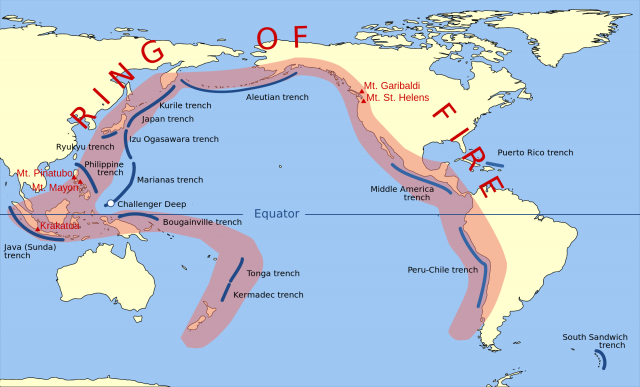Ring of Fire
The Pacific Ring of Fire is an arc of intense EARTHQUAKE (seismic) and volcanic activity stretching from NEW ZEALAND, along the eastern edge of Asia, north across the ALEUTIAN ISLANDS of ALASKA, and south along the coast of North and South America. It is made up of over 75 percent of the world's active and dormant volcanoes. The Ring of Fire is located along the borders of the Pacific Plate and other tectonic plates. It was recognized and described before the development of the relatively new and generally accepted science of PLATE TECTONICS theory.
Volcanoes are not randomly distributed over the Earth's surface, most are concentrated on the edges of CONTINENTS, along island chains, or beneath the sea, forming long mountain ranges. The peripheral areas of the Pacific Ocean Basin, containing the boundaries of several plates are dotted by many active volcanoes. More than half of the world's active volcanoes that are above sea level encircle the PACIFIC OCEAN to form the Pacific Ring of Fire. The ring is an example of plateboundary volcanoes. According to the theory of plate tectonics, scientists believe that the Earth's surface is broken into a number of shifting slabs or plates, which average about 50 mi (80 km) in thickness. These plates move relative to one another above a hotter, deeper, more mobile layer that moves at rates as great as a few inches per year. Most of the world's active volcanoes are located along or near the boundaries between shifting plates and are called plate-boundary volcanoes.

Some active volcanoes are not associated with plate boundaries and are called intraplate volcanoes, which form roughly linear chains in the interior of some oceanic plates. The Hawaiian Islands provide an example of an intraplate volcanic chain, developed by the northwest-moving Pacific Plate passing over an inferred hot spot that initiates magma generation and the volcano formation process.
The Ring of Fire around the Pacific represents one type of this volcanism. The chains of volcanoes in the island arcs (such as the Aleutian Islands) and continental margins (such as the ANDES) around much of the ocean form above moving oceanic plates. Plates are like giant floats on the Earth's surface, which slide next to, collide with, and are forced underneath other plates. Around the Ring of Fire, the Pacific Plate is colliding with and sliding underneath other plates.
This is called subduction and the volcanically and seismically active area is known as the subduction zone. There is a great amount of energy created by these plates; it melts rock into magma that rises to the surface as lava and forms volcanoes. Volcanoes are temporary features on the Earth's surface. There are currently about 1,500 active volcanoes in the world of which 10 percent are located in the UNITED STATES. Volcanic areas in the Ring of Fire include:
- South America—the Nazca plate colliding with the South American plate has created the Andes and volcanoes such as Cotopaxi and Azul.
- Central America—the small Cocos plate is moving into the North American plate, forming the Mexican volcanoes of Popocatepetl and Paricutun (which rose up from a cornfield in 1943 and instantly became mountains).
- Northern CALIFORNIA and British Columbia, CANADA—the Pacific, Juan de Fuca, and Gorda plates created the Cascades and Mount Saint Helens (in washington state), which erupted in 1980.
- ALASKA—the Aleutian Islands are growing as the Pacific plate hits the North American plate. The deep Aleutian Trench has been created at the subduction zone with a maximum depth of 25,194 ft (7,679 m).
- RUSSIA's Kamchatka Peninsula to JAPAN—the subduction of the Pacific plate under the Eurasian plate formed the Japanese islands and volcanoes (such as Mt. Fuji).
- The final section of the Ring of Fire exists where the Indo-Australian plate subducts under the Pacific plate and has created volcanoes in the New Guinea and MICRONESIA areas.